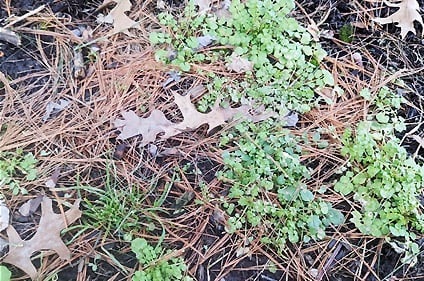Following Poa are weeds like catchweed bedstraw, common chickweed, marestail, corn speedwell, purple deadnettle, shepherd’s purse, prickly lettuce, and pictured here, annual bluegrass with hairy bittercress and some henbit.
Many of these weeds will first be visible near buildings or hard surfaces and structures as soil temperatures will warm there quicker than out in the lawn. These areas are aptly named microclimates as they tend to be affected by temperatures, rainfall, and winds differently.
These weeds are generally sensitive to phenoxy and many other common post-emergent herbicides, but the challenge is effectiveness when the weeds first become visible. Weeds must be actively growing for uptake, and though these weeds are visible, very little else is taking place. These facts make management much more difficult.
Although amine formulations of common phenoxy herbicides (2,4-D and MCPP and others) are safer, one might consider an ester option. Esters will penetrate the waxy cuticle of the leaf better during cooler months but do have some temperature restrictions as they will volatilize easier causing off-target plant damage.
On many labels, you will see a maximum temperature of 85 degrees F on most cool season grasses and 80 degrees F on Centipede and St. Augustine. Most amine formulations are safe to use up to 90 degrees F. The other option for cooler temperatures are the products that contain Carfentrazone (Speedzone) or Pyraflufen-ethyl which will speed up control. The downside here is that none of these will have any activity on grassy weeds including Poa.
The other approach is late summer to early fall applications of a pre-emergent herbicide. Some will control grassy and limited broadleaf weeds, conversely some are stronger just on broadleaves. Prodiamine, Pendimethalin, and Dithiopyr will be strong on grassy weeds while somewhat limited in terms of broadleaf control.
Pre-emergent options containing dimethenamid-p (Freehand), isoxaben, and combinations of trifluralin and isoxaben (T/I) will have a much broader label in terms of broadleaf activity. Broadstar is another effective option for use in landscape beds. Make sure to read the label to see where these products can be applied, non-target plant safety, and watering instructions prior to use.
Here's information from Turfgrass Science at Purdue University with outstanding pictures to help with identification. Please feel free to contact the Ewing Technical Services Team for identification and product recommendations.




